Design for manufacturability (DFM) is a concept that is gaining importance in the manufacturing industry. It refers to the design of a product with the ease of manufacturing in mind. DFM aims to reduce the manufacturing costs of a product while maintaining its quality, functionality, and performance. By designing a product that is easy to manufacture, manufacturers can reduce their production time, minimize waste, and increase their profitability.
Design for manufacturability involves several design principles that designers must consider during the design process. These principles include designing parts that are easy to manufacture, selecting materials that are readily available, designing parts that can be easily assembled, and designing parts that can be manufactured using the available manufacturing processes. By following these principles, designers can ensure that their product is easy to manufacture, thereby reducing the manufacturing costs and improving the overall quality of the product.
Key Takeaways
- Design for manufacturability is a concept that aims to reduce the manufacturing costs of a product while maintaining its quality, functionality, and performance.
- Designers must consider several design principles during the design process, including designing parts that are easy to manufacture, selecting materials that are readily available, and designing parts that can be easily assembled.
- By designing a product that is easy to manufacture, manufacturers can reduce their production time, minimize waste, and increase their profitability.
Design Principles
Design for manufacturability is a critical aspect of product design that focuses on optimizing the design for efficient, cost-effective, and high-quality manufacturing. The following design principles can help achieve this objective:
Material Selection
Material selection is an essential aspect of product design that can impact the manufacturing process significantly. The designer should select materials that are readily available, cost-effective, and have the necessary properties to meet the product's functional requirements. The designer should also consider the material's compatibility with the manufacturing process, as some materials may be difficult to process or require specialized equipment.
Simplicity and Standardization
Simplicity and standardization are key principles of design for manufacturability that can help reduce manufacturing costs and improve product quality. The designer should strive to simplify the product design by reducing the number of components and minimizing the complexity of the manufacturing process. Standardization of components and processes can also help reduce costs and improve quality by eliminating variations and improving efficiency.
Tolerance Analysis
Tolerance analysis is an important aspect of product design that can impact the product's functionality and manufacturing process. The designer should carefully consider the tolerances of each component to ensure that they are within the acceptable range. Tolerance “stack-up” refers to how the tolerance of multiple parts add up, and how that impacts manufacturing and functionality. The designer should also consider the impact of the tolerances on the manufacturing process, as tighter tolerances may require more precise equipment and increase manufacturing costs. By optimizing the tolerances, the designer can improve product quality and reduce manufacturing costs.
In summary, the design principles of material selection, simplicity and standardization, and tolerance analysis can help achieve efficient, cost-effective, and high-quality manufacturing. By considering these principles during the design process, the designer can optimize the product design for manufacturability and improve the overall product quality.
Design for Assembly
Design for Assembly (DFA) is a method of designing products to optimize the ease of assembly. DFA aims to reduce the number of parts, minimize the number of assembly operations, and simplify the assembly process. This approach can lead to significant cost savings by reducing labor and assembly time.
Component Integration
Component integration is a key aspect of DFA. By integrating multiple components into a single part, the number of parts required for assembly can be reduced. This not only simplifies the assembly process but also reduces the number of parts that need to be manufactured. For example, by integrating a handle and a latch into a single part, the number of parts required for assembly can be reduced by two.
Modularity
Modularity is another important aspect of DFA. By designing products to be modular, individual components can be easily assembled and disassembled. This can lead to a significant reduction in assembly time and can also simplify maintenance and repair operations. For example, by designing a product with modular components, a faulty component can be easily replaced without having to disassemble the entire product.
In conclusion, DFA is an important aspect of design for manufacturability. By designing products with assembly in mind, significant cost savings can be achieved by reducing labor and assembly time. Component integration and modularity are two key aspects of DFA that can help simplify the assembly process and reduce the number of parts required for assembly.
Process Considerations
Machining Processes
When designing for manufacturability, it is important to consider the machining processes that will be used to create the final product. Machining processes such as milling, turning, and drilling can be used to create complex shapes and features, but they can also add significant cost to the manufacturing process.
To minimize costs, designers should consider using standard tool sizes and shapes, as well as minimizing the number of machining operations required. Additionally, designers should pay attention to the material properties of the part being machined, as certain materials may require more specialized machining processes.
Injection Molding
Injection molding is a popular manufacturing process for producing large quantities of plastic parts. When designing for injection molding, designers should consider factors such as part geometry, material selection, and mold design.
Part geometry can significantly impact the cost and feasibility of injection molding. Parts with complex geometries, thin walls, or deep undercuts may require more specialized molds and processes, which can add to the overall cost of production.
Material selection is also important in injection molding. Different materials have different properties, such as stiffness, strength, and temperature resistance, which can impact the performance of the final part. Additionally, some materials may require more specialized processing conditions, such as higher temperatures or longer cooling times.
Finally, mold design is critical in injection molding. The mold must be designed to allow the plastic to flow into all areas of the part, while also minimizing the amount of material used. Proper venting and cooling channels are also important to ensure consistent part quality and reduce cycle times.
Cost Optimization
Economic Analysis
Design for manufacturability is an essential process that ensures products are produced at the lowest possible cost while maintaining quality standards. Economic analysis is a crucial aspect of the design for manufacturability process. It involves evaluating the cost of production and identifying areas where costs can be reduced.
One way to reduce costs is by selecting the right materials. Materials can have a significant impact on the cost of production. Choosing cheaper yet high-quality materials can significantly reduce production costs. Additionally, reducing the number of parts used in a product can also lower production costs.
Another way to reduce costs is by optimizing the manufacturing process. By streamlining the production process, manufacturers can reduce the time and labor required to produce a product, which in turn lowers production costs.
Reducing Complexity
Reducing complexity is another critical aspect of cost optimization in design for manufacturability. Complex designs can increase production costs and make it challenging to manufacture products efficiently. Simplifying designs can reduce the number of parts required and make it easier to manufacture products.
Designers can also reduce complexity by standardizing parts and components. Standardization makes it easier to manufacture products in large quantities, which can lower production costs.
In conclusion, cost optimization is a crucial aspect of design for manufacturability. By conducting an economic analysis and reducing complexity, manufacturers can produce high-quality products at the lowest possible cost.
Product Lifecycle
Design for manufacturability (DFM) is an essential aspect of product development that focuses on the ease of manufacturing a product. DFM considers the entire product lifecycle, from design to end-of-life disassembly.
Sustainability
Sustainability is a critical consideration in the product lifecycle. DFM can help reduce the environmental impact of a product by designing it to be more sustainable. This can include reducing the amount of material used, designing for recyclability, and minimizing the energy required to manufacture and transport the product.
DFM can also help reduce the environmental impact of a product by designing it to have a longer lifespan. This can include selecting materials that are more durable and designing the product to be easily repairable.
End-of-Life Disassembly
End-of-life disassembly is an important aspect of product lifecycle management. DFM can help make the disassembly process more efficient and cost-effective. This can include designing the product with fewer parts, making the parts easier to disassemble, and using materials that are easier to recycle.
DFM can also help reduce the environmental impact of end-of-life disassembly. By designing the product with recyclable materials, the amount of waste generated during disassembly can be reduced. Additionally, designing the product with fewer parts can reduce the amount of energy required to disassemble the product.
Overall, DFM is an essential aspect of product development that considers the entire product lifecycle. By designing products that are more sustainable and easier to disassemble, DFM can help reduce the environmental impact of products and improve the efficiency and cost-effectiveness of the manufacturing process.
Frequently Asked Questions
What are the key principles of Design for Manufacturability?
Design for Manufacturability (DFM) is a set of guidelines that aim to optimize the design of a product for efficient and cost-effective manufacturing. The key principles of DFM include simplifying the design, minimizing the number of parts, using standard parts and materials, and designing for ease of assembly and testing.
How does Design for Assembly (DFA) complement Design for Manufacturability (DFM)?
Design for Assembly (DFA) is a subset of DFM that focuses on optimizing the design of a product for ease of assembly. DFA complements DFM by identifying opportunities to reduce the number of parts, simplify the assembly process, and minimize the risk of errors during assembly.
What are the common challenges encountered when integrating DFM practices?
One common challenge when integrating DFM practices is resistance from designers who are accustomed to focusing solely on product functionality. Another challenge is balancing the trade-offs between design complexity and manufacturability. Additionally, implementing DFM practices may require changes to existing manufacturing processes and equipment.
How does material selection impact the manufacturability of a product?
Material selection can have a significant impact on the manufacturability of a product. Some materials may be difficult to work with or require specialized equipment, which can increase manufacturing costs. Additionally, some materials may have limited availability or long lead times, which can cause delays in production.
In what ways can early-stage design decisions influence the ease of manufacturing?
Early-stage design decisions can have a significant impact on the ease of manufacturing. For example, decisions related to part geometry, tolerances, and surface finish can impact the complexity of manufacturing processes. Similarly, decisions related to material selection and part consolidation can impact the number of parts required and the overall complexity of the design.
What are some best practices for incorporating DFM guidelines during the product development process?
Some best practices for incorporating DFM guidelines during the product development process include involving manufacturing experts early in the design process, using design for assembly software tools, conducting design reviews to identify potential issues, and using standardized design practices and materials. Additionally, it is important to continually evaluate and refine the design throughout the development process to ensure that it is optimized for manufacturability.
.jpg)



